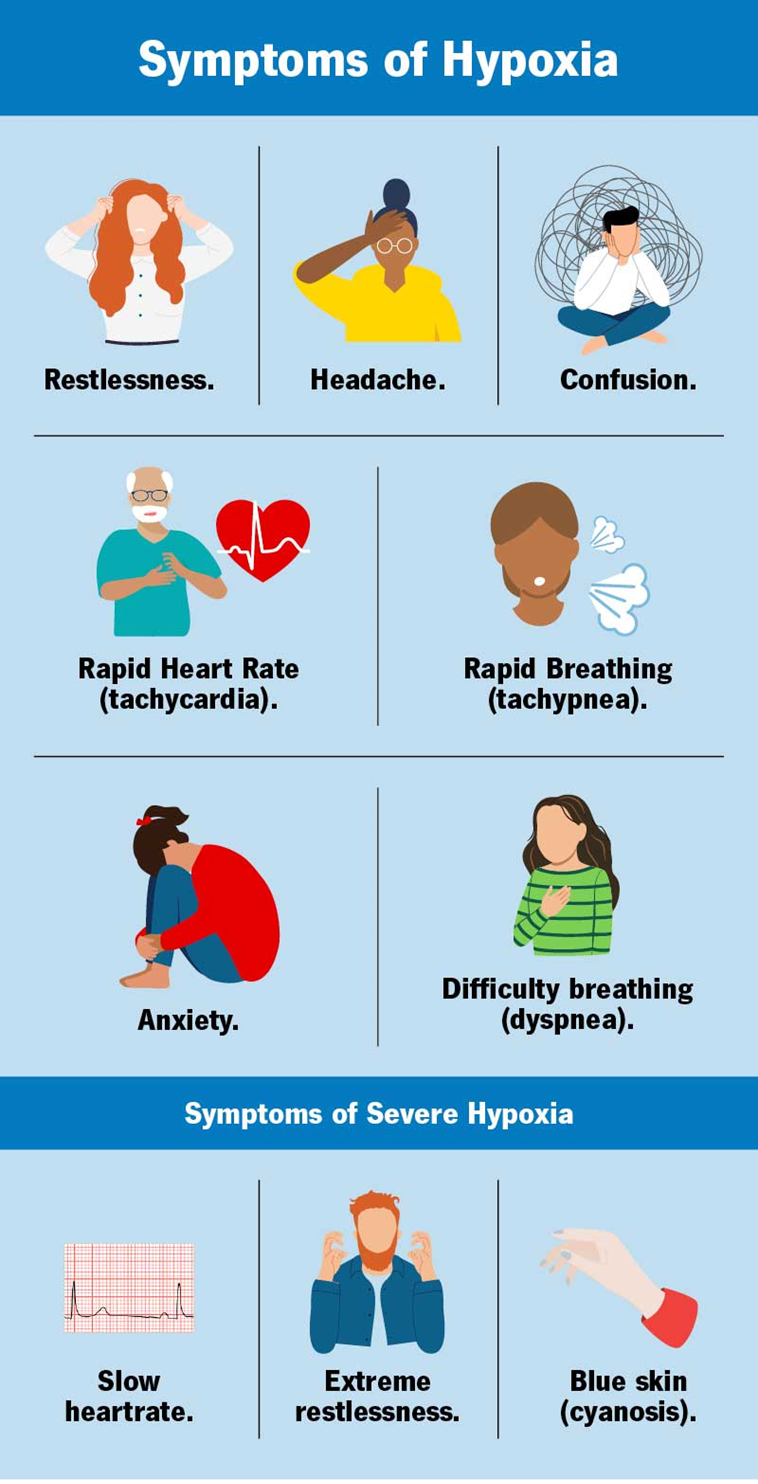Which clinical manifestation is most reflective of an early response to hypoxia?
Restlessness
Cyanosis
Apnea
Bradycardia
The Correct Answer is A
Choice A Reason:
Restlessness is often one of the earliest signs of hypoxia. When the body experiences low oxygen levels, the brain is one of the first organs to be affected. This can lead to symptoms such as anxiety, agitation, and restlessness as the brain struggles to function properly without adequate oxygen. These symptoms occur because the body is trying to compensate for the lack of oxygen by increasing respiratory and heart rates, which can make a person feel uneasy or restless.

Choice B Reason:
Cyanosis refers to a bluish discoloration of the skin and mucous membranes due to low oxygen levels in the blood. While cyanosis is a significant indicator of hypoxia, it is typically a later sign. By the time cyanosis is visible, hypoxia has usually been present for some time, and oxygen levels have been critically low. Therefore, it is not the earliest clinical manifestation of hypoxia.
Choice C Reason:
Apnea is the absence of breathing. This is a severe and late sign of hypoxia. When a person stops breathing, it indicates that the body has been deprived of oxygen for an extended period, leading to critical conditions. Apnea is a medical emergency and requires immediate intervention, but it is not an early sign of hypoxia.
Choice D Reason:
Bradycardia is a slower than normal heart rate. Like apnea, bradycardia is a late sign of hypoxia. Initially, the body responds to low oxygen levels by increasing the heart rate (tachycardia) to pump more oxygenated blood to tissues. Bradycardia occurs when the body can no longer compensate, and the heart rate slows down, indicating severe hypoxia and impending failure of the cardiovascular system.
Nursing Test Bank
Naxlex Comprehensive Predictor Exams
Related Questions
Correct Answer is D
Explanation
Choice A Reason:
Urinary tract infections (UTIs) are typically caused by bacteria entering the urinary tract. While strict bed rest can increase the risk of UTIs due to factors like catheter use and reduced mobility, the use of an incentive spirometer does not directly prevent UTIs. Instead, preventing UTIs involves maintaining good hygiene, ensuring adequate fluid intake, and, if necessary, using catheters properly.
Choice B Reason:
Deep vein thrombosis (DVT) is a condition where blood clots form in the deep veins, usually in the legs. This can occur due to prolonged immobility, such as strict bed rest after surgery. Preventing DVT involves measures like using compression stockings, administering anticoagulant medications, and encouraging leg exercises. An incentive spirometer, which is used to improve lung function, does not directly prevent DVT.
Choice C Reason:
Constipation is a common issue for patients on bed rest due to reduced physical activity and changes in diet. Preventing constipation involves ensuring adequate hydration, providing a high-fiber diet, and encouraging as much physical activity as possible. The use of an incentive spirometer, which focuses on respiratory function, does not directly address constipation.
Choice D Reason:
Atelectasis is a condition where the alveoli in the lungs collapse, leading to reduced or absent breath sounds in the affected areas. This is a common postoperative complication, especially in patients on strict bed rest, due to shallow breathing and reduced lung expansion. The use of an incentive spirometer encourages deep breathing and helps to keep the alveoli open, thereby preventing atelectasis. This is why the incentive spirometer is an essential tool for postoperative respiratory care.
Correct Answer is B
Explanation
Choice A reason: Referring a client because the unit is too busy is not an appropriate reason for a healthcare referral. Referrals should be based on the client’s specific needs and the expertise required to address those needs. Overcrowding or busyness of a unit should be managed through internal resources and staffing adjustments rather than referrals.
Choice B reason: When the care needed for the client is out of the healthcare provider’s scope of practice, a referral is necessary. This ensures that the client receives the appropriate level of care from a specialist or another provider with the required expertise. Referrals help in providing comprehensive and specialized care that the initial provider may not be equipped to deliver.
Choice C reason: Referring a client because they do not have insurance is not appropriate. Healthcare providers should assist clients in finding resources and support for their care needs, regardless of their insurance status. Referrals should be based on clinical needs, not financial or insurance considerations.
Choice D reason: Referring a client because they are late is not a valid reason for a healthcare referral. Timeliness is important, but it should not determine the need for a referral. Providers should address the reasons for lateness and work with the client to ensure they receive the necessary care.
Whether you are a student looking to ace your exams or a practicing nurse seeking to enhance your expertise , our nursing education contents will empower you with the confidence and competence to make a difference in the lives of patients and become a respected leader in the healthcare field.
Visit Naxlex, invest in your future and unlock endless possibilities with our unparalleled nursing education contents today
Report Wrong Answer on the Current Question
Do you disagree with the answer? If yes, what is your expected answer? Explain.
Kindly be descriptive with the issue you are facing.
